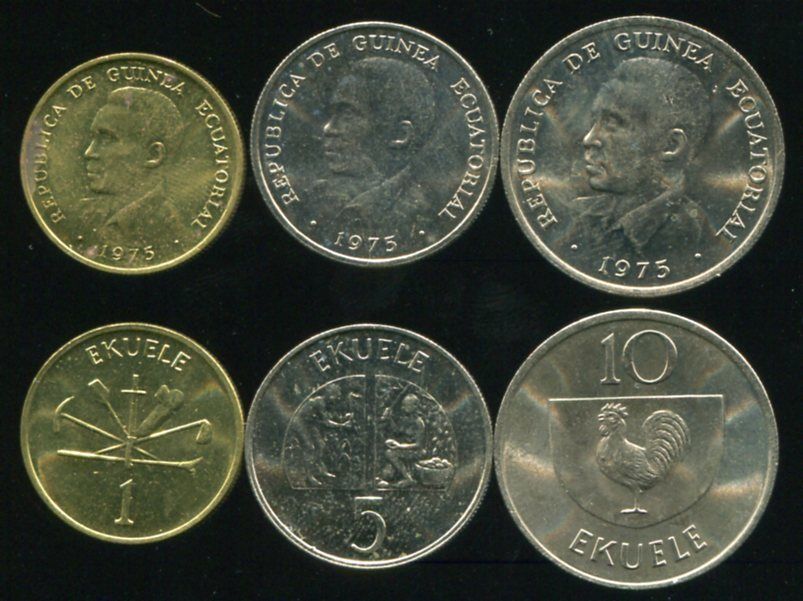Equatorial Guinean Ekwele on:
[Wikipedia]
[Google]
[Amazon]
The ekwele or ekuele was the

currency
A currency is a standardization of money in any form, in use or circulation as a medium of exchange, for example banknotes and coins. A more general definition is that a currency is a ''system of money'' in common use within a specific envi ...
of Equatorial Guinea
Equatorial Guinea, officially the Republic of Equatorial Guinea, is a country on the west coast of Central Africa. It has an area of . Formerly the colony of Spanish Guinea, its post-independence name refers to its location both near the Equ ...
between 1975 and 1985. Although nominally divided into 100 ''céntimos'', no subdivisions were issued. The name ekuele (plural the same) was used until 1979, whilst ekwele (plural ''bipkwele'') was used after. The renaming of the currency to "ekwele" from "peseta" was motivated largely by a sweeping Africanization
Africanization or Africanisation (lit., making something African) has been applied in various contexts, notably in geographic and personal naming and in the composition of the civil service via processes such as indigenization.
Africanization ...
program meant to rid the country of its colonial past by removing Spanish names and references from the public domain; the ''ekpele'' was a pre-colonial iron
Iron is a chemical element; it has symbol Fe () and atomic number 26. It is a metal that belongs to the first transition series and group 8 of the periodic table. It is, by mass, the most common element on Earth, forming much of Earth's o ...
currency used by the Fang
A fang is a long, pointed tooth. In mammals, a fang is a modified maxillary tooth, used for biting and tearing flesh. In snakes, it is a specialized tooth that is associated with a venom gland (see snake venom). Spiders also have external fangs, ...
and Beti people.
The ekuele replaced the '' peseta guineana'' at par, whilst the ekwele was replaced by the Central African CFA franc
The Central African CFA franc ( French: ''franc CFA'' or simply ''franc''; ISO code: XAF; abbreviation: F.CFA) is the currency of six independent states in Central Africa: Cameroon, Central African Republic, Chad, Republic of the Congo, Equator ...
(written ''franco'' on Equatorial Guinean coins and banknotes) at a rate of 1 Franco = 4 bipkwele.
Coins
The first ekuele coins were issued in 1975. All denominations depicted the first presidentFrancisco Macías Nguema
Francisco Macías Nguema (born Mez-m Ngueme, later Africanisation, Africanised to Masie Nguema Biyogo Ñegue Ndong; 1 January 1924 – 29 September 1979), often referred to as Macías Nguema or simply Macías, was an Equatoguinean politician w ...
on the obverse and allegorical motifs on the reverse. These were aluminum-bronze 1 ekuele and copper nickel 5 and 10 ekuele denominations. In 1980 and 1981, coins of 1 ekwele, 5, 25 and 50 bipkwele were issued, replacing the previous coins which were then withdrawn from circulation. The smallest denomination was again issued in aluminum-bronze while the higher denominations were in copper nickel. This time all denominations featured the second president, Teodoro Obiang Nguema Mbasogo
Teodoro Obiang Nguema Mbasogo (; born 5 June 1942) is an Equatoguinean politician, former commissioned officer, military officer and dictator who has served as the second president of Equatorial Guinea since 1982. Previously, he was the Chairm ...
and had a design plan similar to the 1969 Equatorial Guinean peseta
The peseta (''peseta guineana'') was the currency of Equatorial Guinea from 1969 to 1975. It replaced the Spanish peseta at par shortly after gaining independence from Spain the prior year and was later replaced, again at par, by the ekwele.
...
issue. This second issue was made in smaller quantities than the previous ones and these coins are considerably rare today. After 1985 Equatorial Guinea joined the Economic Community of Central African States and all local coins were replaced by coins of the Central African CFA franc.

Banknotes
The "Banco Popular" issued notes in denominations of 25, 50, 100, 500, and 1000 ekwele from 1975 printed by the Thomas De La Rue banknote company. After the fall of the Macías government the financial system was reformed with the "Banco de Guinea Ecuatorial" taking over the production of paper money in 1979 and issuing notes in denominations of 100, 500, 1000, and 5000 bipkwele. This second series as printed by Fábrica Nacional de Moneda y Timbre in Spain. After 1985 all local banknotes were withdrawn and replaced by banknotes of the Central African CFA franc.References
{{n-end Currencies of Africa Modern obsolete currencies Economy of Equatorial Guinea 1975 establishments in Equatorial Guinea 1985 disestablishments in Equatorial Guinea